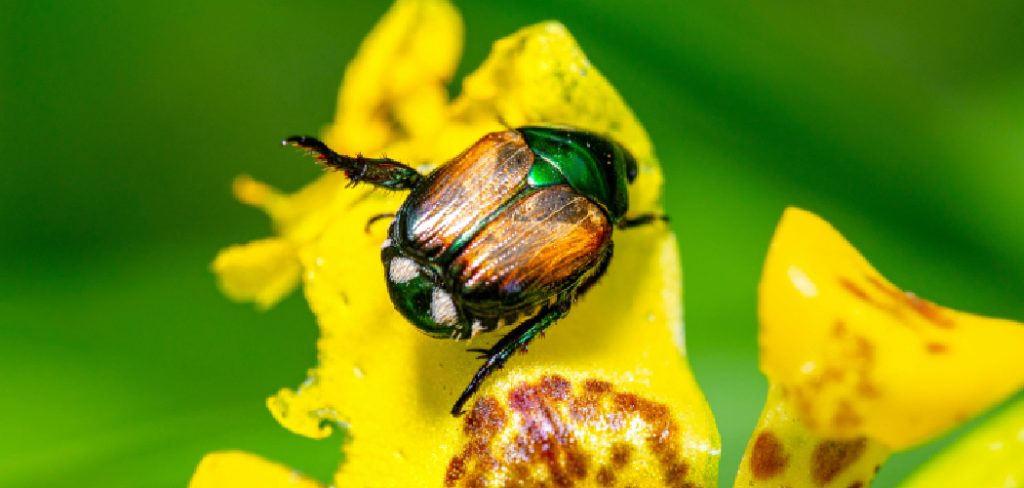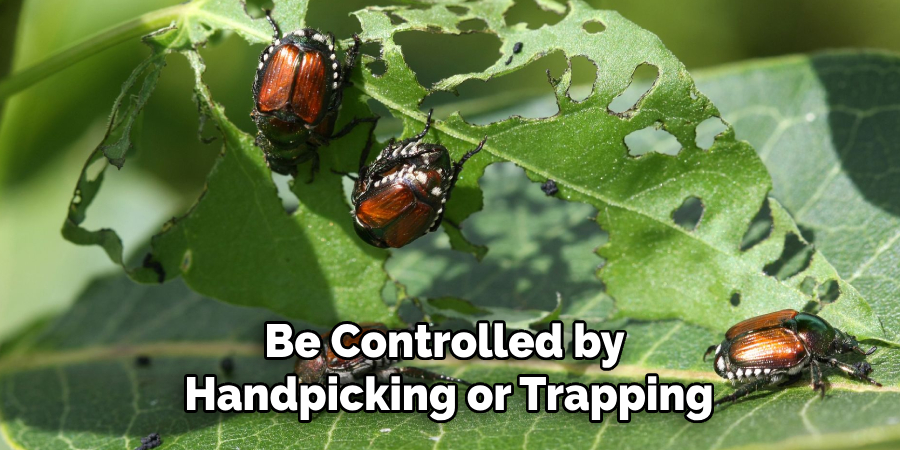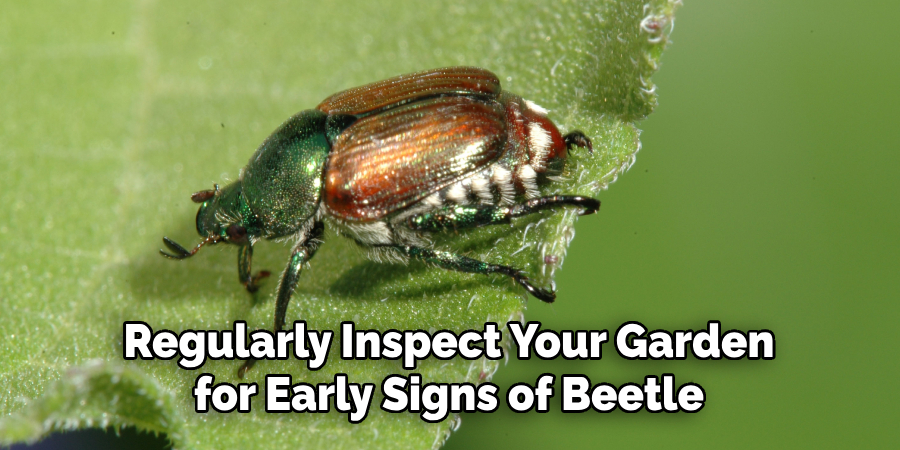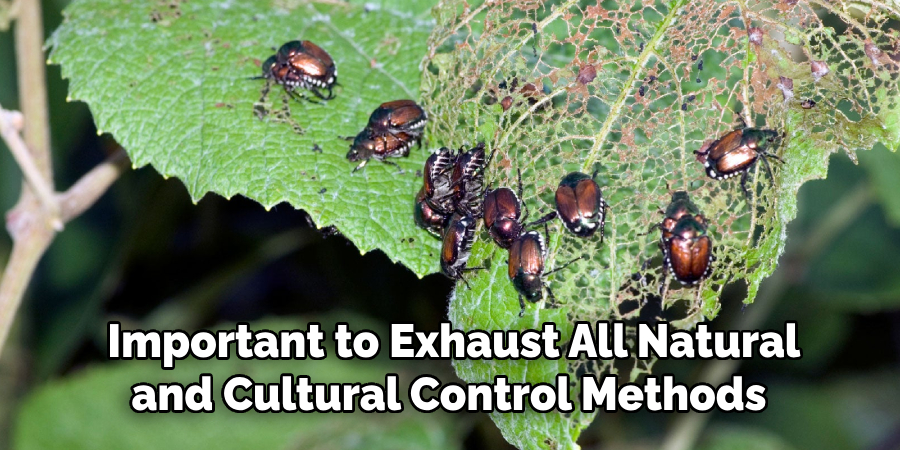Japanese beetles can be a gardener’s worst nightmare. These invasive pests feed on the leaves, flowers, and fruits of over 300 plant species, leaving behind skeletonized foliage that can weaken or kill your plants. Managing these beetles effectively requires a combination of preventative measures and active removal techniques to protect your garden and maintain its health.

In this guide on how to get japanese beetles off plants, we’ll explore practical and proven methods to get rid of Japanese beetles and keep your plants thriving.
Why Are Japanese Beetles a Problem?
Japanese beetles are native to Japan, but were accidentally introduced to the United States in 1916. They quickly spread throughout the country and have become a major pest for gardeners and farmers alike. These beetles are known for their voracious appetite and ability to decimate entire plants in a matter of days.
Aside from causing damage to plants, Japanese beetles can also attract other pests like birds and rodents, which feed on the larvae that develop in your soil. This can create an endless cycle of infestation if not properly addressed.
Needed Materials
To effectively control Japanese beetles, you will need a few materials. These include:
Handpicking Tools:
Since Japanese beetles are easily visible and slow-moving, handpicking is an effective method of control for small gardens. You can use tools like a small bucket of soapy water or a handheld vacuum to collect the beetles.
Traps:
There are various types of traps available for Japanese beetle control, such as pheromone traps and floral lure traps. These attract the beetles and trap them, reducing their population in your garden.
Insecticides:
If your infestation is too large to be controlled by handpicking or trapping, you may need to use insecticides. However, it is important to choose an insecticide specifically designed for Japanese beetles and follow the instructions carefully to avoid harming beneficial insects.

Natural Predators:
Another option for controlling Japanese beetles is introducing natural predators into your garden. These can include birds, parasitic wasps, and nematodes, which feed on beetle eggs and larvae.
Crop Rotation:
Rotating your crops each year can also help reduce Japanese beetle infestations. By planting different crops in different locations each season, you can disrupt the beetle’s life cycle and prevent them from building up a large population in one area.
5 Simple Step-by-Step Guidelines on How to Get Japanese Beetles Off Plants
Step 1: Inspect Your Plants for Japanese Beetles
Begin by examining your plants closely to identify signs of Japanese beetle activity. Look for the beetles themselves, which are recognizable by their metallic green bodies and copper-colored wings.
Additionally, check for evidence of damage, such as skeletonized leaves, which result from their feeding habits. Pay special attention to high-risk plants like roses, grapevines, and linden trees. Conducting these inspections early in the morning is ideal, as Japanese beetles are less active during this time, making them easier to spot and manage.
Step 2: Implement Control Measures
Once Japanese beetles are spotted, it is essential to take prompt and effective action to minimize their impact on your plants. Begin by manually removing the beetles; this can be done by shaking the affected plants early in the morning and collecting the insects in a bucket of soapy water to prevent their return.
You can also use insecticidal sprays labeled specifically for Japanese beetles, ensuring they are applied as directed to avoid harming beneficial insects. If the infestation is severe, consider using traps strategically placed away from the garden to lure beetles out of vulnerable areas. Additionally, introducing natural predators, such as parasitic wasps or nematodes, can help control beetle populations over time. Employing a combination of these methods will improve the chances of protecting your plants effectively.
Step 3: Preventing and Managing Future Infestations
To reduce the likelihood of future Japanese beetle infestations, proactive measures should be taken. Start by maintaining healthy soil and robust plant life, as strong plants are less susceptible to damage. Regularly inspect your garden for early signs of beetle activity and take immediate action if detected.

Consider planting beetle-resistant plant species, such as marigolds, begonias, or boxwoods, which are less attractive to these pests. Additionally, practicing crop rotation can disrupt the beetle’s lifecycle if grubs are present in the soil. During late summer or early fall, treat your lawn with beneficial nematodes or milky spore, which target beetle larvae before they mature. By combining these preventative strategies, you can help safeguard your garden and minimize the risks of recurring infestations.
Step 4: Encouraging Biodiversity
One of the most effective ways to prevent and control Japanese beetle infestations is by promoting biodiversity in your garden. Planting a diverse range of plant species can help deter beetles from targeting a specific crop or area. It also encourages the presence of beneficial insects, such as ladybugs, lacewings, and predatory wasps, which feed on beetle eggs and larvae.
Furthermore, creating natural habitats for these beneficial insects can further enhance their population in your garden. This can include providing shelter, such as piles of leaves or rocks, and planting native plants that attract these helpful predators.
Step 5: Seeking Professional Help
If you are facing a severe Japanese beetle infestation, it may be necessary to seek professional help. A licensed pest control expert can provide more targeted and effective methods of control, such as using pesticides or specialized traps.
However, it is important to note that these methods should not be the first line of defense against Japanese beetles. It’s important to exhaust all natural and cultural control methods before resorting to chemical solutions.

Also, when seeking professional help, make sure to carefully research and select a reputable company with experience in dealing with Japanese beetles specifically.
Following these steps on how to get japanese beetles off plants can help ensure a healthy and pest-free garden.
Common Mistakes to Avoid
When dealing with Japanese beetles, there are several common mistakes that can hinder your efforts or potentially harm your plants. One major mistake is overusing chemical pesticides without considering their impact on beneficial insects and overall soil health. Another error is neglecting to remove spent flowers and fruits, which can attract more beetles to your garden.
Many gardeners also make the mistake of not addressing the problem promptly, allowing infestations to grow uncontrollably. Additionally, improper timing when using traps can backfire, as it might inadvertently attract more beetles to your yard. Avoiding these pitfalls is crucial for effective control and maintaining the long-term health of your plants.
Frequently Asked Questions
Q: Can Japanese Beetles Be Harmful to Humans?
A: While Japanese beetles do not pose a direct threat to human health, they can cause skin irritation if handled. Their droppings also have the potential to spread disease if they come into contact with food or water sources. However, the biggest concern is the damage they can cause to plants and gardens.
Q: How Can I Prevent Japanese Beetles from Infesting My Garden?
A: Prevention is key when it comes to dealing with Japanese beetles. Some ways to prevent them from infesting your garden include planting non-preferred plants such as garlic, chives, and catnip around your garden, using row covers to physically block them from reaching plants, and removing any dead plant material that may attract them. In addition, practicing good garden hygiene by regularly removing weeds and debris can also help prevent Japanese beetle infestations.
Q: What Else Can I Do to Prevent Japanese Beetles From Infesting My Garden?
A: In addition to the methods mentioned, there are a few other steps you can take to prevent Japanese beetles from infesting your garden. One is using traps specifically designed for Japanese beetles that contain a pheromone lure to attract them away from your plants and into the trap. These traps should be placed at least 30 feet away from your garden to avoid attracting more beetles than necessary.
Q: Should I Use Chemical Pesticides?
A: While chemical pesticides can be effective in controlling Japanese beetles, they are not always the best solution. These pesticides can also harm beneficial insects and pollinators in your garden. If you do choose to use a pesticide, make sure it is specifically labeled for Japanese beetle control and follow the instructions carefully.

Another option is using natural predators of Japanese beetles such as birds, wasps, and certain types of nematodes. You can attract these predators to your garden by planting flowers that provide nectar and pollen or installing bird feeders or houses.
Conclusion
Japanese beetles can be a challenging pest to manage, but with a combination of proactive strategies, they can be effectively controlled. Employing natural solutions such as attracting predators, utilizing beneficial nematodes, and practicing crop rotation can significantly reduce their impact.
By maintaining a healthy and biodiverse garden, you create an environment that naturally minimizes pest infestations, allowing your plants to thrive without the need for harsh chemicals. Thanks for reading this article on how to get japanese beetles off plants.
About
Jennifer Branett is a distinguished figure in the world of Garden design, with a decade of expertise creating innovative and sustainable indoor solutions. His professional focus lies in merging traditional craftsmanship with modern manufacturing techniques, fostering designs that are both practical and environmentally conscious. As the author of garden, Jennifer delves into the art and science of garden-fix, inspiring artisans and industry professionals alike.
Education RMIT University
(Melbourne, Australia) Associate Degree in Design (Jennifer Branett) Focus on sustainable design, industry-driven projects, and practical craftsmanship. Gained hands-on experience with traditional and digital manufacturing tools, such as CAD and CNC software.
Nottingham Trent University
(United Kingdom) Bachelor’s in Garden and Product Design (Honors) Specialized in product design with a focus on blending creativity with production techniques. Participated in industry projects, working with companies like John Lewis and Vitsoe to gain real-world insights.Publications and Impact
In indoor, Jennifer Branett his insights on Garden design processes, materials, and strategies for efficient production. His writing bridges the gap between artisan knowledge and modern industry needs, making it a must-read for both budding designers and seasoned professionals.
